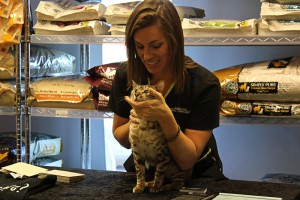How Is Chiropractic Care for Pets Different Than That for People?
- Posted on
- By Dr. Jill Tack
- Posted in about pet chiropractic care, dr. christina cole, how is pet chiropractic care different for pets, pet chiropractic, pet chiropractor
- 0

We're welcoming Dr. Christina Cole of Advanced Animal Chiropractic to our blog today to discuss the differences between chiropractic care for humans and the type of care that she provides for our companions. She does dog and cat adjustments at the shop every two weeks. Her next sessions will be Tuesday, April 7 and Tuesday, April 21.
We're welcoming Dr. Christina Cole of Advanced Animal Chiropractic to our blog today to discuss the differences between chiropractic care for humans and the type of care that she provides for our companions. She does dog and cat adjustments at the shop every two weeks. Her next sessions will be Tuesday, April 7 and Tuesday, April 21.
The first thing I tell most of my animal clients' owners is to take everything they know or think they know about chiropractic care and throw it out the window. Most of this knowledge usually comes from human chiropractic or from generalized stereotypes, neither of which is applicable to animals. While the premise may be the same, the methodology is completely different.
How Structural Chiropractic Care Is Different
For starters, I am not only a different kind of chiropractor in that I focus on animals, but I am also unique to animal chiropractors because my focus is entirely on structural correction. There are only a handful of structural human chiropractors found locally, and even fewer structural animal chiropractors. My goal has always been to present a more lasting and restorative method of health care for animals.
About Structural Chiropractic Care
Your nervous system is composed of the brain and spinal cord and is protected by the spine. This system acts as your control center for most everything in the body including the immune, lymphatic, vascular, and musculoskeletal systems. A variety of micro and macrotraumas will affect every being throughout a lifetime. Microtraumas can be as small as emotional upsets, repetitive daily activities, or mental stressors. Macrotraumas consist of larger incidents like falls, accidents, big life changes, and health pitfalls.
Both of these types of occurrences affect the nervous system indirectly by causing structural shifts in the body, which is what structural chiropractic aims to alleviate. Structural shifts in the body directly affect the nervous system by leading to system interference. There are a number of secondary conditions resulting from structural shifting such as allergies, asthma, constipation, incontinence, limping, pain, mood changes, skin irritation, poor blood flow, coughing, vomiting, lack of mobility, etc. The list goes on and on, but what’s most important to realize is that until the primary condition is addressed (the structural shift), these secondary conditions are unlikely to resolve on a more permanent basis.
What Makes Animal Chiropractic Care Different
The differences between adjusting a human and adjusting an animal are vast. For instance, there will rarely be any “noises” made when an animal gets adjusted due to the difference in intervertebral disc height and the forces on the discs. In addition, when an animal gets adjusted the results are incredibly close to instantaneous. Unlike humans, animals do not have nearly as large of a prefrontal cortex, which controls our logic and allows us to reason in most situations. Because animals either lack or have such a small PFC that it is almost negligible, means they also lack any logical reasoning. This may sound like a bad thing, but it is actually a positive when it comes to chiropractic care. When getting adjusted, animals cannot lie about how they feel or how they respond. Either they feel better and exhibit signs of that, or nothing changes. Conversely, a human has the innate ability to convince him or herself whether or not improvement is noted, and this can overpower the truth in the situation.
There are many more differences between these types of chiropractic care, but what is most important to remember is that your animal should always be seen by a certified animal chiropractor, and not left to someone who is untrained. The technique is different, the patient is different (species), and therefore the professional administering the adjustment also needs to be different.
Please note that all chiropractic care is given with the consent of a veterinarian, veterinarian referral or in a veterinarian office. If you've scheduled an appointment, please bring this completed form with you.


Comments
Be the first to comment...